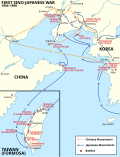Korea under Japanese rule
Korea under Japanese rule is a term to define Korea when it was under Japanese control. Japanese victory in the First Sino-Japanese War in 1895 and in the Russo-Japanese War in 1905 cleared the way. Japan controlled Korea for 35 years during Japanese Imperialism. The Japanese control of Korea lasted from 22 August 1910 until 15 August 1945. The Japanese rulers of Korea left the country on 2 September 1945. In Japan, the more common term is "Korea of the Japanese-Governed Period" (日本統治時代の朝鮮, Nippon Tōchi-jidai no Chōsen). In South Korea, the term is "Korea of the Japanese-Colonial Period" (일제강점기, 日帝強占期, Ilje gangjeomgi).
Korea 朝鮮 Chōsen | |||||||||||||||
|---|---|---|---|---|---|---|---|---|---|---|---|---|---|---|---|
| 1910–1945 | |||||||||||||||
| Anthem: | |||||||||||||||
 Map shows Korea (dark red) within the Empire of Japan (light red) at its furthest extent | |||||||||||||||
| Government | Monarchy | ||||||||||||||
• first Emperor | Meiji (1910–1912) | ||||||||||||||
• last Emperor | Shōwa (1926–1945) | ||||||||||||||
| Establishment | |||||||||||||||
• Japanese protectorate | 1905 | ||||||||||||||
• Full Annexation | 1910 | ||||||||||||||
| 1945 | |||||||||||||||
| |||||||||||||||
| Today part of | North Korea, South Korea | ||||||||||||||
The period is usually divided into three parts. In 1910-1919, the Japanese treated Koreans with military force (무단 통치, 武斷 統治). From 1919 to 1930s they gave Korea some more rights, but still treated them badly (문화 통치, 文化 統治 / 민족 분열 통치, 民族 分裂 統治). However, they later tried to force them to become Japanese from 1930s to their surrender in World War II (민족 말살 통치, 民族 抹殺 統治).
Despite them being allies to the United States and having an interest in each other's cultures, Japanese and Koreans still tend to have suspicion of each other because of how Japan treated Korea during its time as a colony
Korea Under Japanese Rule Media
kimi ga Yo 1930 instrumental
Japanese marines landing from the Unyo at Yeongjong Island which is near Ganghwa
Major battles and troop movements during the First Sino-Japanese War
General power of attorney to Lee Wan-yong sealed and signed, by the last emperor, Sunjong on 22 August 1910 (Hangul: 융희4년; Hanja: 隆熙4年)
Terauchi Masatake, the first Governor-General
Headquarters of the Oriental Development Company in Keijō
In 1921, Japan turned a Korean royal cemetery into a golf course, with the graves still directly on the course. This occurred at what is now Hyochang Park.
Other websites
- Isabella Lucy Bird (1898), Korea and Her Neighbours: A Narrative of Travel, with an Account of the Recent Vicissitudes and Present Position of the Country
- Horace Newton Allen (1908), Things Korean: A Collection of Sketches and Anecdotes, Missionary and Diplomatic
- Hildi Kang (2001), Under the Black Umbrella: Voices from Colonial Korea, 1910-1945, Cornell University Press, ISBN 0-8014-7270-9
- Toshiyuki Mizoguchi, "Consumer Prices and Real Wages in Taiwan and Korea under Japanese Rule" Hitotsubashi Journal of Economics, 13(1): 40-56
- Toshiyuki Mizoguchi, "Economic Growth of Korea under the Japanese Occupation - Background of Industrialization of Korea 1911-1940" Hitotsubashi Journal of Economics, 20(1): 1-19
- Toshiyuki Mizoguchi, "Foreign Trade in Taiwan and Korea under Japanese Rule" Hitotsubashi Journal of Economics, 14(2): 37-53
- Kim, Young-Koo, The Validity of Some Coerced Treaties in the Early 20th Century: A Reconsideration of the Japanese Annexation of Korea in Legal Perspective[dead link]







